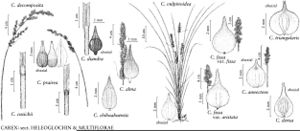Carex alma
Mem. Torrey Bot. Club 1: 50. 1889.
Culms to 90 cm × 2 mm, scabrous. Leaves: sheath fronts spotted redbrown, veinless, plane, apex truncate to convex, membranous; ligule rounded, to 1 mm, free limb to 0.2 mm; blades to 75 cm × 6 mm, shorter than flowering-stem. Inflorescences loosely paniculate, 4–12 cm × 15–20 mm, with 10–20 branches proximal branches distinct; the proximal internode to 25 mm; bracts scalelike, not conspicuous, the awn, when present, 15–50 mm. Scales hyaline, redbrown or pale-brown, margins colorless, broad, shining, apex acute or mucronate. Anthers with prominent apiculus to 0.5 mm. Perigynia dark brown-black, 3–5-veined abaxially, 0–3-veined adaxially, body ovate to lanceolate, 3–4.5 × 1.5–2 mm, base rounded to cordate, conspicuous basal spongy tissue somewhat distending perigynium; beak 1–1.5 mm. Achenes redbrown, ovate, 1.2–1.5 × 1–1.2 mm, glossy; style base cylindric.
Phenology: Fruiting Jul–Aug.
Habitat: Stream banks, springs, seeps in desert regions
Elevation: 600–2700 m
Distribution

Ariz., Calif., Nev., N.Mex., Tex., Mexico (Baja California), Mexico (Sonora)
Discussion
Carex alma has an unusual combination of characteristics for the section. The conspicuous basal sheaths, the basally spongy perigynia tapering to beak, the hyaline acute scales, and the cylindricly enlarged style bases place the species closer to sect. Vulpinae than to other taxa of sect. Multiflorae. Carex agrostoides, here placed in synonymy with C. alma, has previously been distinguished by the green perigynia and absence of basal spongy tissue. All such specimens, including the type, appear to be immature specimens of C. alma in which spongy tissue and mature perigynium coloration have not developed.
Selected References
None.
Lower Taxa
"shortened" is not a number.
